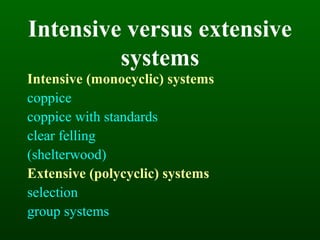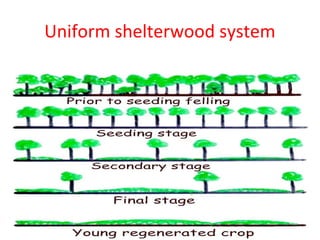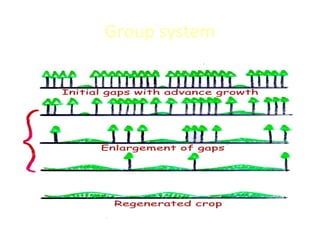Silvicultural systems
- 1. SILVICULTURE “The art and science of reproducing and growing trees and forests in a sustainable manner based on principles of forest ecology for the benefit of society.”
- 2. SILVICULTURAL SYSTEMS A silvicultural system is a series of forestry practices using natural strategies designed to regenerate specific forest types according to landowner objectives. Even-aged vs. Uneven-aged Clearcutting Shelterwood Selection Intermediate Treatments Artificial Regeneration
- 3. NATURAL REGENERATION SeedsSprouts Suckers Layering Most of our forests are regenerated using natural strategies in silvicultural systems. Planting is not necessary but can be successful
- 4. CLEARCUTTING An even-aged system where all or nearly all of the trees are harvested at one time. Forest Types: Pines, Spruces, Oaks Clearcut Seed-Tree
- 5. SHELTERWOOD An even-aged system where one or two cuts are used prior to the final harvest. The first two cuts stimulate and establish advanced regeneration before the final harvest cut. Final Crop Should Be: • Windfirm • Good Seeders • Undamaged by Logging Uniform Group Strip
- 6. SELECTION A selection harvest IS NOT a diameter-limit cut! An uneven-aged system where trees of all sizes are harvested on a cycle of about 10-15 years. Single-Tree Group
- 7. INTERMEDIATE TREATMENTS Nearly any forestry practice not connected with regeneration or harvest can be considered an intermediate treatment. Timber Stand Improvement (TSI) Weeding, Cleaning, Sanitation Cutting Protection Pruning
- 8. TIMBER STAND IMPROVEMENT TSI thinnings are intended to improve the quality of a timber stand. They can be commercial or non-commercial. Low Fork Crooked Crowded Unwanted Species Before TSI After TSI
- 9. ARTIFICIAL REGENERATION We usually think only of the physical act of planting trees, but there is much more to consider in order to achieve success. Species Selection Site Selection Site Preparation Planting Methods Competition Control Direct Seeding Underplanting
- 11. Classification of silvicultural systems 1. coppice systems 2. high forest systems a) regeneration over whole forest which is uneven-aged polycyclic or selection systems b) regeneration concentrated in one part of forest at any one time i) old crop removed in several fellings over years shelterwood systems ii) old crop removed by a single felling monocyclic or clear felling system
- 12. Intensive versus extensive systems Intensive (monocyclic) systems coppice coppice with standards clear felling (shelterwood) Extensive (polycyclic) systems selection group systems
- 14. Group system














